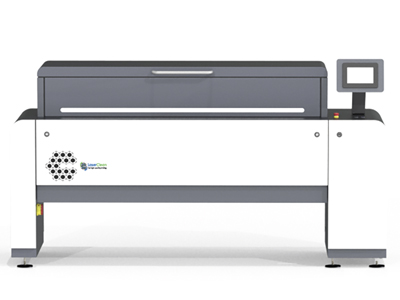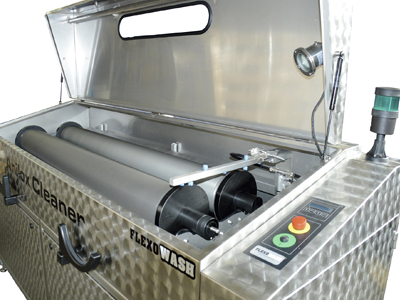The new Flexo Wash anilox cleaner washes two rollers at the same time,
in just 10 minutes
We all know how important the anilox is to the flexo process, and so the cleaning and maintenance of these essential components has to be done with precision and expertise. Michal Lodej explores why this should be taken seriously by all press operators.
Competitive print prices bring pressure to all parts of the production process and with high quality print taken for granted; none is in sharper focus than the anilox roller. With more frequent job changeovers, the anilox, needs proper cleaning, care, and maintenance. So, printers must be aware of the need for good cleaning practices that will cut downtime and bring consistently better print results.
However as anilox companies strive to deliver more sophisticated cell structures, cleaning them can prove to be more difficult. Cells become smaller and so the need for quality cleaning increases, and the deeper the cell, the greater the risk of plugging. Plugging causes problems with hitting the right colour, maintaining colour density, inadequate ink distribution, and a waste of time and substrate. Smaller cells also mean a more delicate cell structure that is susceptible to damage caused by improper handling, doctor blade scoring, and poor cleaning methods.
Abrasive cleaners, pads, and brushes are no longer a reality in today’s production environment of deep or small cells. Instead automated systems are popular among press room staff as not only do they reduce manual labour, they also take away the responsibility of making sure the rollers are cleaned properly; if it is not clean then it is the machine’s fault.
Being proactive
In a perfect world the rollers would be cleaned immediately after use so that the ink or coating is not allowed to dry in the cells. If it does, the cleaning process becomes more difficult, and plugged or dirty anilox rollers create surface tension that prevents cells from accepting and releasing the correct ink volume. Printers know they cannot wait to clean their rollers until they no longer perform, because the market is too competitive. So, they have a problem and must find a solution that reduces set up time, reduces press downtime, minimises waste of ink and substrate, improves productivity, and increases roller life.
Flexo Wash technology uses a safe and gentle cleaning method that will not damage even the thinnest of cell walls. In fact, the cleaning method allows printers to deep clean the rollers and wash them daily, without harming even the finest lines, irrespective of whether the anilox is wet or dry. And this holds true for water based, solvent and/or UV inks, adhesives, lacquers, varnishes, and laminates.
The Flexo Wash FW anilox cleaning system incorporates ‘plug and play’ simplicity. The method is simple. Place the anilox roller in the cleaning unit, close the lid, and push the start button. The entire cleaning process starts with liquid spraying, then rinses with high-pressure water, and finishes with an air blow dry. The whole process is 100% automated. The systematic cleaning process is safe and harmless to the anilox rollers, employees, and the environment. The cell volume is completely restored in just 10 minutes, and the cleaning solution is filtered for multiple re-use, which lowers cost.The only maintenance required is to change the filter every month, and clean the liquid tank every six months.
Reality check
Unfortunately cleaning is not high up on the agenda in many printing companies, and that could be holding them back.
Éric Thibault, business development director at Flexomaid, said, ‘Over the years you have streamlined your operations, cut costs and increased productivity to better respond to increased customer demand, globalisation, and competitive pressure. The question is where can I turn next to improve even more? The next level of improvements are not as obvious as the previous ones were.’
One of the not so obvious places is around the cleanliness of your rolls. With the high cell count used by many printers, it is not easy to spot residues on a cylinder, so your teams can spend hours adjusting colours, doing reruns, rewashing the cylinder, etc.
Mr Thibault continued, ‘So let’s have a look at it: Your procedure probably says to clean the roll after each job, and once cleaned the roll is stored. You had a job some time back and now you have to run the same job. Except for the roll which was spotless before the job and cleaned after it, everything else is the same, the adjustment, the pressure, the ink, etc. So your team starts the run and realises that the colour is not the same and yet, the colour density is different, and certainly not acceptable.
‘Their natural reaction would be to play with the ink, and then they will try to reclean the roll, etc. This would mean more time spent, more ink used, more support material; in other words, less productivity and lower profits.’
The Aeromaid system from Flexomaid, offers a non contact cleaning system with low water consumption. The air-stream powerhead works together with an anilox cleaning detergent assisted by built-in sensors, the software controls every step of the process to ensure cleaning quality. The unit comes in a range of sizes, the smallest has a maximum cleaning length of 736mm, and the largest 2438mm.
Hands off approach
Laser cleaning is another non-contact alternative for cleaning and avoids using chemicals. The Laserclean narrow web laser cleaning machine ALCS 1000 S is a compact system, easy to use, maintenance free, environmental friendly, and most importantly, cleans rollers. Chain wheels and bearings do not need removal and after cleaning the roll can be used immediately.

This unit from Laserclean uses no water or chemicals to clean aniloxes
This system is affordable and a sustainable and economical method for cleaning anilox rollers with no consumables such as granulates, chemicals, or water needed. Additionally, high printing quality can be achieved because laser cleaning restores both the surface tension of the roller and maximises cell volumes, which in turn lowers ink usage.
Anilox rollers regularly come into contact with inks, paints, cleaning agents, water and all manner of chemical substances. The cells on the roller can become clogged, which reduces the volume of the anilox cells concerned. This compromises the performance of the anilox roller and eventually the printing results. Therefore printers must be able to fully rely on their anilox cleaner. But the range of products available on the market for anilox cleaning is varied, and it is becoming more and more difficult for the user to find a high-quality product for their needs. Moreover, the cleaning solution must be clearly selected in regards to the specific settings such as. applied inks, cleaning cycles and use of cleaning machines.
Zecher, as manufacturer of anilox rollers, recently launched its own line of cleaning products with four cleaners matched to different applications. The versions are Aqua/UV Ink, Gel, In-Line and Washing Machine which allow for gentle and efficient cleaning. Aqua/UV Ink was specially developed for water and UV-based inks and varnishes on anilox rollers and printing equipment. You can use this water dilutable cleaner for in-line washing systems as well as manual cleaning of your anilox rollers. Gel is biodegradable and can be used for manual cleaning or in combination with an ultrasonic bath. This gel has been specifically formulated for the periodical cleaning of cylinders and rollers for printing. In-Line can be used with an in-line washing system in combination with a heating tank or to clean your anilox rollers manually. It is a concentrated cleaning agent that has been developed for daily or periodical cleaning of surfaces polluted with water- or solvent-based inks. Washing Machine is designed for the exclusive use in equipment washing machines. You can use this alkaline cleaner for the periodical cleaning of water- and solvent-based inks on your
anilox rollers.
Read the full October/November issue of FlexoTech here. Subscribe to the magazine for free – register your details here.






